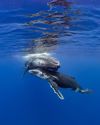Prøve GULL - Gratis
Cerulean Colossus
ASIAN Geographic
|AG 169
A little introduction to the world's biggest fish

The whale shark, Rhincodon typus, is a slow-moving filter feeding shark and the largest extant fish species The whale shark is perhaps one of the great mysteries of our ocean; the biggest fish in the sea and yet it was not described by science until 1828. Though estimated to have existed for over 60 million years, however, only a meagre 320 records of its occurrence existed until 1986, mainly noting that the adults of this species weigh tens of tonnes, yet only feed upon microscopic plankton, while recent years have brought with them research programmes, tourism, plenty more sightings and a lot more science. Today, many questions still remain. How did such a large animal escape our notice for so long? And how is it that now, with hundreds of papers published, there are still great holes in our knowledge of this species?
Let's start with what we do know. Firstly, there is the prestigious title of the biggest fish in the sea. The largest reported whale shark to date was documented in Taiwanese fishery in 1987 at a giant 20 metres and weighing in at a massive 34 tonnes! With the capacity to reach such a great size, it has been estimated that these animals might live as long as 150 years. Their confusing name often leads many to think of them as whales, not sharks, but the whale part of the name is perhaps more of a nod to its great size, as well as the ecological similarities they share with these mammals, roaming the oceans in search of their planktonic food.
We also know now that these giants are usually found in all tropical and warm temperate seas, usually, with a few exceptions, between the latitudes of 30°N and 30°S. Whale shark sightings have been reported in both oceanic and coastal waters, with much of what we now know and understand about these giant fish being gleaned from seasonal and relatively predictable coastal aggregations of these animals that form at various locations around the world.
Denne historien er fra AG 169-utgaven av ASIAN Geographic.
Abonner på Magzter GOLD for å få tilgang til tusenvis av kuraterte premiumhistorier og over 9000 magasiner og aviser.
Allerede abonnent? Logg på
FLERE HISTORIER FRA ASIAN Geographic

ASIAN Geographic
Cerulean Colossus
A little introduction to the world's biggest fish
6 mins
AG 169

ASIAN Geographic
Tales from the Black Sea
A glimpse of hope
7 mins
AG 169

ASIAN Geographic
The Magnificent Seven
There are seven marine turtle species worldwide, three of which are listed as “Endangered” or “Critically Endangered”. Each have their own habitats, needs and peculiarities, but how much longer will we be able to enjoy their presence on our planet?
4 mins
AG 169
ASIAN Geographic
Ocean Giants
Understanding the enigmatic mantas and other mobula rays
9 mins
AG 169

ASIAN Geographic
10 Top Diving Experiences in the Philippines
The Philippines is renowned worldwide for its breathtaking marine biodiversity, crystal-clear waters, and vibrant coral reefs. Boasting over 7,000 islands, the archipelago offers countless diving spots that cater to beginners and seasoned divers alike. Whether you're seeking thrilling encounters with sharks, exploring world-class wrecks, or immersing yourself in colourful coral gardens, the Philippines has something extraordinary to offer. Here are 10 of the best diving experiences you should add to your bucket list.
1 min
AG 169

ASIAN Geographic
Introducing Hippocampus Unravelling the Seahorse
Seahorses are an elusive species that turn divers giddy with excitement. But what is it about them that fascinates people so much? Quite often, throughout my work and travels, I hear divers say, \"I don't like sharks – they're scary\" or \"Nudibranchs are boring\", but can you ever recall a time when you've heard a diver say that they don't like seahorses? I mean, what is there not to like about this mythical little creature?
3 mins
AG 169

ASIAN Geographic
Go for the Glow
The science behind coral colours
2 mins
AG 169

ASIAN Geographic
Revealed Silver
Known in Latin as argentum, originating from the Sanskrit word argunas meaning \"shining\", silver is often an overlooked metal in comparison to gold, though it has properties that make it a unique and special element.
2 mins
AG 166

ASIAN Geographic
Celebrating the 2023 Rolex Awards for Enterprise Laureate: Liu Shaochuang
As a part of the Perpetual Planet Initiative, the Rolex Awards for Enterprise continues to expand the initiative’s growing portfolio, supporting exceptional individuals with innovative projects in areas such as the environment, science and health, applied technology, cultural heritage, and exploration.
2 mins
AG 166

ASIAN Geographic
The Treasures of Tahiti and the Journey of Giants
For decades, French Polynesia's beguiling islands have adorned travel brochures, alluring honeymooners with turquoise lagoons, overwater bungalows, and lush volcanic peaks. Some 7,000 kilometres from its closest neighbours, and spread over five main island groups, the French territory's real treasures are not just what you see in the splashy brochures. Get ready for untamed, wild, ocean encounters.
6 mins
AG 166
Listen
Translate
Change font size

